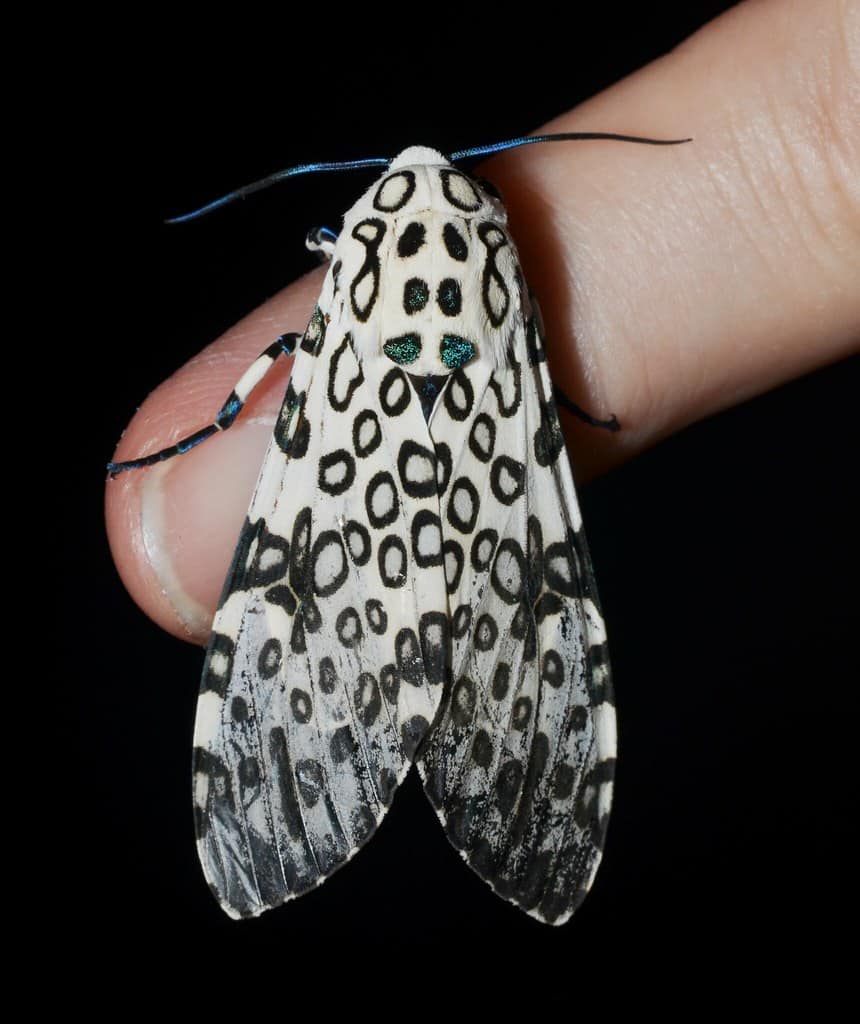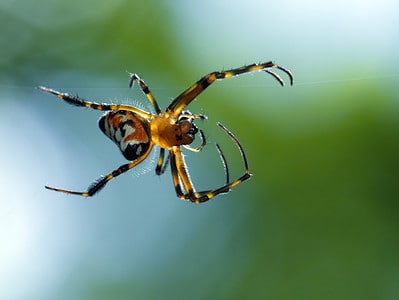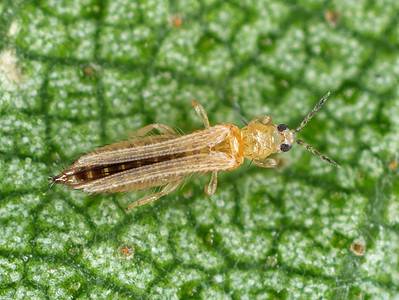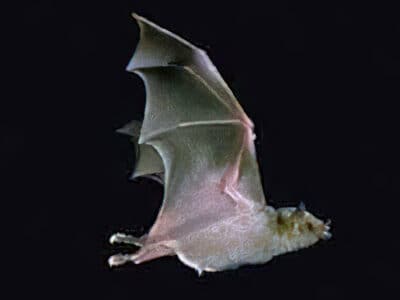When giant leopard moths mate, their mating sessions last over 24 hours.
Advertisement
Giant Leopard Moth Facts
- Fun Fact
- When giant leopard moths mate, their mating sessions last over 24 hours.
- Most Distinctive Feature
- These moths are as large as a human palm.
- Distinctive Feature
- Large white wings with black dogs
- Wingspan
- Males have a wingspane of three inches and are almost twice as large as females.
- Diet
- Omnivore
- Lifestyle
- Nocturnal
- Solitary
- Group
- Favorite Food
- Adults: cabbage, dandelion, violet, willow, sweet orange, black locust, flamevine, magnolia, and plantain. Caterpillars enjoy As a caterpillar, the giant leopard moth like to eat broad-leafed plants, including lettuce and sunflowers. They also enjoy eating the leaves from several different types of trees, like willows and cherry trees.
- Type
- Moth
- Common Name
- Giant Leopard Moth
View all of the Giant Leopard Moth images!
The giant leopard moth starts out as a prickly black caterpillar.
It has orange markings across its body and although its prickly fur appears to cause injury, these bristles on their bodies aren’t urticant, which means they don’t splinter off when touched. You could touch it gently with your fingertips—although, it may curl up in defense. Another defense mechanism giant leopard moths use is the release of yellow fluid from their thoraxes. After a period of hibernation, the caterpillar emerges as the giant leopard moth, to enjoy a nocturnal life.
6 Giant Leopard Moth Facts
Learn 6 interesting facts that set giant leopard moths aside from other types of moths.
- If you spot a giant leopard moth near lights at night, it’s like a male because females are less drawn to the brightness.
- These moths start out as black, prickly caterpillars.
- Giant leopard moths enjoy broad-leafed plants and leaves from different types of trees.
- These moths only take flight at night because they are nocturnal.
- When threatened, giant leopard moths release yellow fluid to keep predators away.
- When giant leopard moths mate, their mating sessions last over 24 hours.
Species, Types, and Scientific Name
The scientific name for the giant leopard moth is Hypercompe from the H. scribonia species. It is also commonly referred to as the tiger moth. It’s from the Erebidae family, which is a family of moths from the superfamily Noctuoidea. There are over 70,000 species of moths that form this superfamily—they refer to “night owl” moths that can be found traveling throughout the night.
This species of moth was previously recognized as part of the Arctiidae family. However, they were reclassified because of their nocturnal lifestyles. The males are highly attracted to bright lights at night, while the females are less commonly found swirling about lights with their male counterparts.
The giant leopard math has two subspecies:
- H. s. scribonia
- H. s. denudate
The name doesn’t lie—these moths are as large as a human palm. They have a wingspan of three inches and the males are almost twice as large as the females. They’re easy to spot because of their unique black and white spotted pattern. As “wooly bear” caterpillars, they hibernate during the winter months and spin into cocoons during springtime.
Appearance
Giant leopard moths have a beautiful, easy-to-spot appearance. The males and females have slightly different appearances, but both have large white wings peppered with black dots. Some of the dots are solid, while others are hollow. On the top side of their abdomens, you can spot a dark blue, iridescent color with some orange markings.
The bottom side of their abdomens is like their wings—white with black spots. Their legs are also black and white but instead of spotted, these colors are banded. Male leopard moths have a distinctive yellow line on each of their sides.
These moths can sometimes be spotted living together with other moths on a tree. However, these are solitary creatures, and they don’t typically live in groups. However, the males and females come together to mate. Their average litter size is about 50 eggs. Their spotted wing design is ideal for helping them blend in with their surroundings and avoid predators.

Giant leopard moths moths are as large as a human palm, with a wingspan of three inches and the males are almost twice as large as the females.
©Andy Reago & Chrissy McClarren (Wildreturn) / CC BY 2.0, Flickr – License
Habitat
Giant leopard moths can be found in forest environments. This is where they find host plants. However, they do travel and can be spotted in public areas like farmlands and gardens. They love environments like fields and meadows as well. Host plants include:
- Cabbage
- Dandelion
- Violet
- Willow
- Sweet Orange
- Black Locust
- Flamevine
- Magnolia
- Plantain
- And more!
Specific Locations Where this Insect Is Found
The giant leopard moth can be found in different countries, ranging from southern Canada, throughout the United States, and through several South American countries, all the way down to Colombia. These countries include:
Diet
As a caterpillar, these moths enjoy broad-leafed plants. This can include anything from lettuce to sunflowers. They also enjoy eating the leaves from several different types of trees, like willows and cherry trees.
Prevention: How to Get Rid of Giant Leopard Moths
Giant leopard moths may sometimes be found in areas close to where humans reside, like in gardens or under wood chips where they rest. Since these insects are nocturnal, it’s not common for you to spot one, unless you spend a lot of time outdoors at night. The male moths are attracted to bright lights, so if you intend to spend time outdoors at night, use a bug shield to keep the male leopard moths away.
If you’re interested in learning about different types of moths, check out the links below:
View all 170 animals that start with GGiant Leopard Moth FAQs (Frequently Asked Questions)
Are giant leopard moths dangerous?
No, moths don’t contain poison and don’t pose a danger to humans. They are unable to bite, particularly once they’re fully grown, which makes them harmless to humans.
How do you identify a giant leopard moth?
You can identify a giant leopard moth by its size and the colors on its wings. It’s a large moth, growing big enough to fit on a human palm, and is colored white with black spots. Some of the black spots are filled in while others are open, allowing the white to shine through the middle.
Thank you for reading! Have some feedback for us? Contact the AZ Animals editorial team.
Sources
- Entomology and Nematology Department, University of Florida, Available here: https://entnemdept.ufl.edu/creatures/MISC/MOTHS/Hypercompe_scribonia.htm
- American Association for the Advancement of Science , Available here: https://www.aaas.org/news/weird-wonderful-creatures-giant-leopard-moth

















